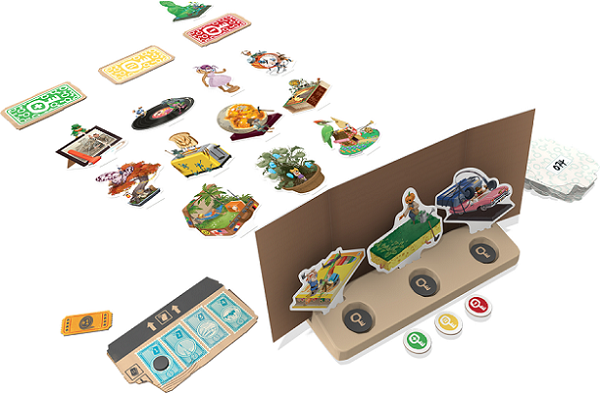One Key: Clue Giving With Simultaneous Play and Minimal Downtime

Published by Libellud and designed by the minds behind Obscurio, One Key is a cooperative clue giving and image interpretation game that seeks to minimize downtime and keep rounds moving quickly.
One player prepares the clues for the next round while the others seek to decipher this round’s clues and discard any cards they believe are not the key they’re searching for. With rounds lasting three minutes, turns are kept short and games fast.
Gameplay
One player is the leader, who knows which of the eleven clue cards in the center of the table is the key that the other players, the travelers, are attempting to locate. Each clue card shows some kind of fanciful image or picture.
The game is played over four rounds. At the start of the first round, the leader draws a clue card and places it above one of the three tiles on the table to indicate the clue card's connection to the key. The red tile indicates if a clue card has a weak or no link to the key, the yellow tile indicates that the link is uncertain or nebulous, while the green tile indicates that the connection between the clue and the key is strong. Any clue cards given by the leader are always placed above these tiles, while the potential key cards on the table can be shifted around beneath these tiles to reflect what the traveler players are thinking and how confident they are about the likelihood that each card is the key.
Next you move onto the simultaneous phase of the round. The three minute timer is started. The travelers can discuss any clues they've been given, moving around the eleven cards in the center of table in an effort to reflect their thoughts, and ultimately select one of the eleven options to discard. Each round they have to discard more and more cards — on the first round they discard only one, but by round four they are discarding four cards. If they do not discard enough cards before the timer runs out or they accidently discard the key, everyone loses the game.
During this same three minute period, the leader draws three clue cards, and sets them up behind a screen. He then assigns token for each one (the tokens come in yellow, red, or green, and the leader may use the same color for more than one clue) based on each clue's connection to the key. However, he places the tokens face-down so that the color cannot be seen. At the start of subsequent rounds, rather than simply drawing a clue card and assigning it to one of the colored tiles, the leader will reveal the three clue cards he worked with from the previous round, and the travelers will pick one. He will then reveal the colored token he assigned to it, and place the clue card above the appropriate colored tile, while the others are returned to the game box. Once only, the travelers may spend one bonus token during the game to select two clues during this phase.
If after four rounds only the key remains in the center of the table, the players win the game.

Review
One Key shares many elements in common with games such as Mysterium and Obscurio while distilling the gameplay down into something simpler and faster — without losing any of the clue giving fun, and bringing a few new ideas to the table.
There is very little downtime in One Key, and we loved that there is never a point during which the players are waiting on the clue giver to present his clues. Having the leader prepare the clues for the next round during the simultaneous phase, ensures that both parties are always engaged in the gameplay and not waiting on each other. We also enjoyed that the travelers actively take part in choosing which clue they want, which is a unique twist.
Three minutes is a great balance for the simultaneous portion of the round. Just long enough that players don’t feel too rushed, and you can still enjoy the discussion that is always fun in this type of game, but short enough to add a little bit of pressure and also keep things moving along. The speed of the game is perfect, as it enables you to easily play several times and allow everyone to try out the two different roles.
The game comes with a free app that can be used for as a timer for both roles and also offers completion buttons for players to hit once they finish their actions. It's nicely designed, but not strictly necessary for gameplay.
While gameplay is simple, the rulebook is a little bit difficult to grasp initially, as the order in which some of the information is presented is a bit muddled. It's a game that is easier to be taught by someone else, than to learn alone. Since the game does come with a free app, it does seem like a wasted opportunity not to use it to make the learning process easier.
If you enjoy clue giving games, One Key is absolutely one that is worth checking out. It is approachable and fast, with lovely artwork and attractive components. It brings together ideas you may have seen in other games but puts them together in a refreshing, more accessible way.
Pros: Little downtime for either role, fast rounds, attractive components
Cons: Rulebook is a little confusing







